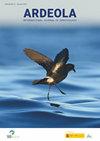森林破碎化对亚马逊地区鸟类羽毛皮质酮水平的影响
IF 1.2
4区 生物学
Q2 ORNITHOLOGY
引用次数: 5
摘要
总结。在亚马逊,水电大坝的建设是生物多样性丧失的一个紧急驱动因素,创造了许多陆桥岛屿,其中大多数无法维持与完整森林相媲美的鸟类物种组合。虽然我们了解了森林破碎化对物种丰富度和分布的影响,但我们仍然需要揭示生物在受干扰栖息地成功生存的生理机制。本研究以羽毛皮质酮水平作为应激生理指标,评估皮质酮水平是否反映栖息地破碎化对物种发生的影响。由于数据表明较小的岛屿会降低栖息地的适宜性,增加生活在其中的鸟类的压力,我们预测生活在较小岛屿上的鸟类会呈现出更高的羽毛皮质酮水平。我们在13个不同大小的岛屿和两个连续的森林中捕获了鸟类,并分析了来自8个不同物种的265只个体的羽毛皮质酮水平。总的来说,我们的研究结果不支持皮质酮与岛屿大小有关的假设,除了圭亚南Antwarbler hypnemis cantator,它呈现出预测的模式:羽毛皮质酮水平随着岛屿大小的增加而降低。这些差异表明,物种对碎片化驱动的压力源的反应不同。有必要进行进一步的研究,以评估皮质酮水平作为应激生理测量的可靠性,并确定哪些参数有助于了解人类活动造成的隔离如何影响鸟类种群对栖息地干扰的抵抗力。-Bicudo, T., ancies, M., Arregui, L. & Gil, D.(2020)。森林破碎化对亚马逊地区鸟类羽毛皮质酮水平的影响。中国生物医学工程学报,26(6):229-245。本文章由计算机程序翻译,如有差异,请以英文原文为准。
Effects of Forest Fragmentation on Feather Corticosterone Levels in an Amazonian Avian Community
Summary. In the Amazon, the construction of hydroelectric dams is an emergent driver of biodiversity loss, creating numerous land-bridge islands, most of them unable to sustain an assemblage of bird species comparable to the intact forest. Although we understand the effects of forest fragmentation on species richness and distribution, we still need to uncover the physiological mechanisms underlying the success of organisms living in disturbed habitats. In this study, we used feather corticosterone levels as a measurement of physiological indicators of stress, evaluating whether corticosterone levels mirror the effects of habitat fragmentation on species occurrence. Since data suggest that smaller islands can reduce habitat suitability, increasing stress in birds that live within them, we predicted that birds living in smaller islands would present increased feather corticosterone levels. We captured birds in 13 islands of varying size and in two continuous forests and analysed feather corticosterone levels of 265 individuals from eight different species. Overall, our findings did not support the hypothesis that corticosterone varies in relation to island size, except for the Guianan Antwarbler Hypocnemis cantator, which presented the predicted pattern: decreasing feather corticosterone levels with increasing island size. These differences suggest that species respond differently to stressors driven by fragmentation. Further studies are necessary to assess the reliability of corticosterone levels as a physiological measurement of stress and to determine which parameters are useful to understand how insularisation caused by human activities may influence the resistance of avian populations to habitat disturbances. —Bicudo, T., Anciães, M., Arregui, L. & Gil, D. (2020). Effects of forest fragmentation on feather corticosterone levels in an Amazonian avian community. Ardeola, 67: 229-245.
求助全文
通过发布文献求助,成功后即可免费获取论文全文。
去求助
来源期刊
CiteScore
2.30
自引率
6.20%
发文量
16
审稿时长
>12 weeks
期刊介绍:
Ardeola: International Journal of Ornithology is the scientific journal of SEO/BirdLife, the Spanish Ornithological Society. The journal had a regional focus when it was first published, in 1954. Since then, and particular during the past two decades, the journal has expanded its thematic and geographical scope. It is now a fully international forum for research on all aspects of ornithology. We thus welcome studies within the fields of basic biology, ecology, behaviour, conservation and biogeography, especially those arising from hypothesis-based research. Although we have a long publication history of Mediterranean and Neotropical studies, we accept papers on investigations worldwide.
Each volume of Ardeola has two parts, published annually in January and July. The main body of each issue comprises full-length original articles (Papersand Review articles) and shorter notes on methodology or stimulating findings (Short Communications). The publication language is English, with summaries, figure legends and table captions also in Spanish. Ardeolaalso publishes critical Book Reviewsand PhD-Dissertation Summaries; summarising ornithological theses defended in Spain. Finally there are two Spanish-language sections, Ornithological News; summarising significant recent observations of birds in Spain, and Observations of Rare Birds in Spain, the annual reports of the Spanish Rarities Committee.

 求助内容:
求助内容: 应助结果提醒方式:
应助结果提醒方式:


